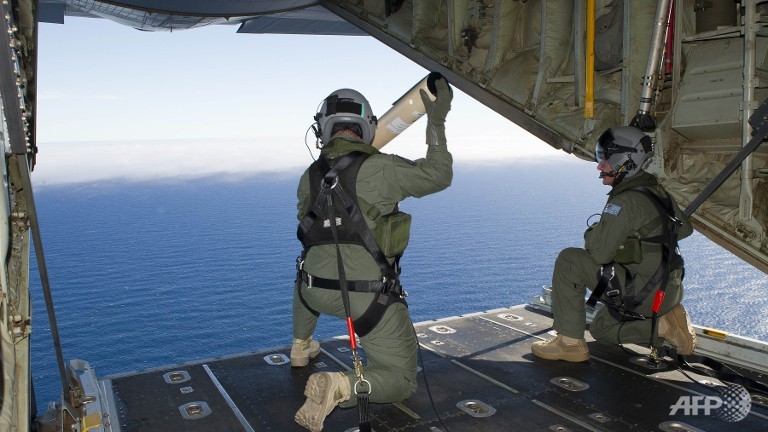Australia resumes Indian Ocean search for possible plane debris

Royal Australian Air Force loadmasters prepare to launch a self-locating data marker buoy from a C-130J Hercules aircraft in the Indian Ocean as part of Australia's assistance to the search for Malaysia Airlines flight MH370. (AFP PHOTO / AUSTRALIAN DEFENCE/LEADING SEAMAN JUSTIN BROWN)
>> Australia resumes ocean search for possible plane debris
PERTH, Australia: Australia resumed the search Friday for possible wreckage from a missing Malaysian jetliner in a remote, storm-swept stretch of the Indian Ocean, hoping for better weather as spotters seek to identify the objects shown on grainy satellite images.
Nearly two weeks after Malaysia Airlines flight MH370 vanished from civilian radar over the South China Sea, the search focus has switched to an isolated section of ocean 2,500 kilometres southwest of Perth.
Satellite images have emerged showing two indistinct floating objects in the area -- the largest estimated at 24 metres across -- which Australia and Malaysia have described as "credible" leads.
Five aircraft were taking part in Friday's operations -- three Australian air force P-3 Orions, a US Navy P-8 Poseidon and a civil Bombardier Global Express jet.
Hampering the effort is the distance from the west coast of Australia, which allows the planes only about two hours of actual search time before they must return to Perth.
A Norwegian merchant ship is already helping scour the search area, but Australia's HMAS Success, which is capable of retrieving any wreckage, was still days away.
Poor weather has compounded the difficulty in finding the objects. Australia's Bureau of Meteorology said rain showers eased Friday but that drizzle, low cloud cover and reduced visibility would continue.
Although Australian Prime Minister Tony Abbott cautioned that the objects may yet prove to be the latest in a number of false leads, his announcement of the satellite image analysis galvanised a search that had seemed stuck in a downward spiral of frustration and recrimination.
The nature of the events that diverted MH370 from its intended flight path on March 8 remain shrouded in mystery, although Malaysian investigators have stuck to their assumption that it was the result of a "deliberate action" by someone on board.
Three scenarios have gained particular attention: hijacking, pilot sabotage, and a sudden mid-air crisis that incapacitated the flight crew and left the plane to fly on auto-pilot for several hours until it ran out of fuel and crashed.
If the objects in the remote southern Indian Ocean are shown to have come from MH370, some analysts believe the hijacking theory will lose ground.
"The reasonable motives for forcing the plane to fly there are very, very few," Gerry Soejatman, a Jakarta-based independent aviation analyst, told AFP.
The area is well off recognised shipping lanes, and the Norwegian car transporter was understood to have taken two days to reach it.
"It's really off the beaten track," said Tim Huxley, chief executive of Wah Kwong Maritime Transport Holdings in Hong Kong. "It's a lonely, lonely place."
For the anguished relatives of the 227 passengers on board, who have already endured an agonising nearly two-week wait, the Australian "find" is a sombre development.
Sarah Bajc, the partner of American passenger Philip Wood, said she had clung to the notion of a hijacking plot that might result in the passengers' eventual safe return.
"So if this debris is indeed part of that plane, then it kind of dashes that wishful thinking to pieces," Bajc told CNN.
"So I really hope it's not a part of the plane, but, you know, if it is, then at least we can go down another path of deciding that maybe we need to start preparing for another scenario instead."
The satellite images were taken on March 16, meaning the satellite-tagged objects would have been drifting for days in a volatile maritime region.
"The current there is one of the strongest in the world, moving at as fast as one metre per second," said Gan Jianping, an oceanographer at the Hong Kong University of Science and Technology.
If debris is found, the mammoth task remains of locating the "black box" flight data recorder, which offers the best chance of peeling back the layers of confusion and mystery surrounding MH370's disappearance.
Malaysia has been criticised for its handling of the crisis, especially by relatives who have accused authorities and the flag-carrier airline of providing insufficient or misleading information.
Nearly two-thirds of the passengers were Chinese nationals. Some of their family members refused to accept the ocean objects indicated a possible crash.
"My son is still alive. My son is still alive. I don't believe the news," cried Wen Wancheng, 63, one of a group of relatives who have spent the last two weeks holed up in a Beijing hotel.
There has been little progress in what essentially became a criminal investigation after it was determined that the disappearance of MH370 was probably deliberate.
Malaysia has asked the FBI to help recover data it said was deleted from a home flight simulator belonging to the plane's chief pilot, Captain Zaharie Ahmad Shah, but otherwise no evidence has emerged to implicate him.
What the stars mean:
★ Poor ★ ★ Promising ★★★ Good ★★★★ Very good ★★★★★ Exceptional
Latest News
More News
- Thailand seeks to promote digital training (November 04, 2024 | 16:14)
- Indonesia attracts foreign investment in technology sector (November 04, 2024 | 16:08)
- Tropical storm Trami leaves at least 24 people dead in Philippines (October 24, 2024 | 17:36)
- Singapore grants conditional approval for solar power import from Australia (October 24, 2024 | 17:27)
- ASEAN digital economy set to reach $2 trillion by 2030 (October 22, 2024 | 15:08)
- Thailand asks Laos to waive visa fee at border checkpoints to boost tourism (October 21, 2024 | 17:23)
- Laos pledges to continue efforts to empower girls (October 21, 2024 | 17:17)
- Chinese electric vehicle maker to build plant in Indonesia (October 21, 2024 | 17:12)
- Vietnam Elevator Association introduces Elevator Safety Application to the world (October 18, 2024 | 09:00)
- A taste of the future - the go-to spot at the Worldchefs Congress & Expo 2024 (October 15, 2024 | 16:11)




















 Mobile Version
Mobile Version